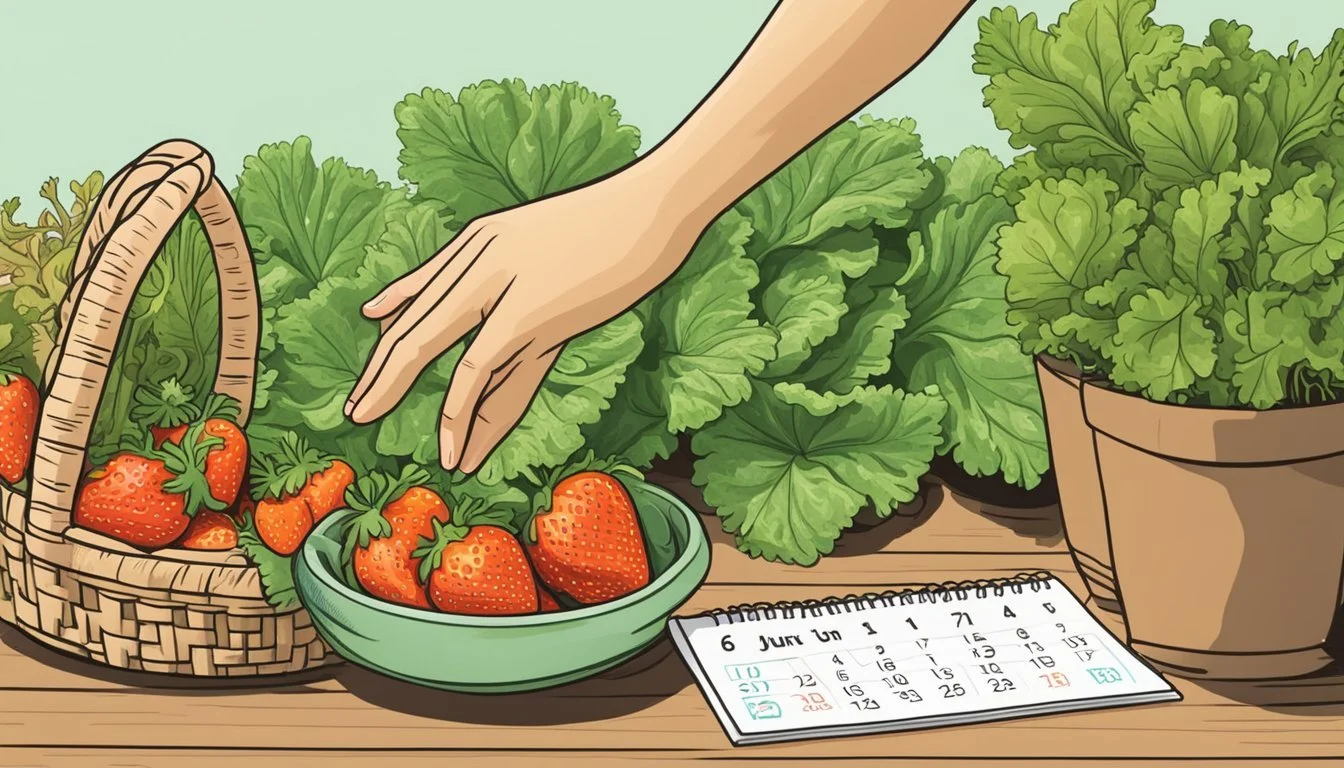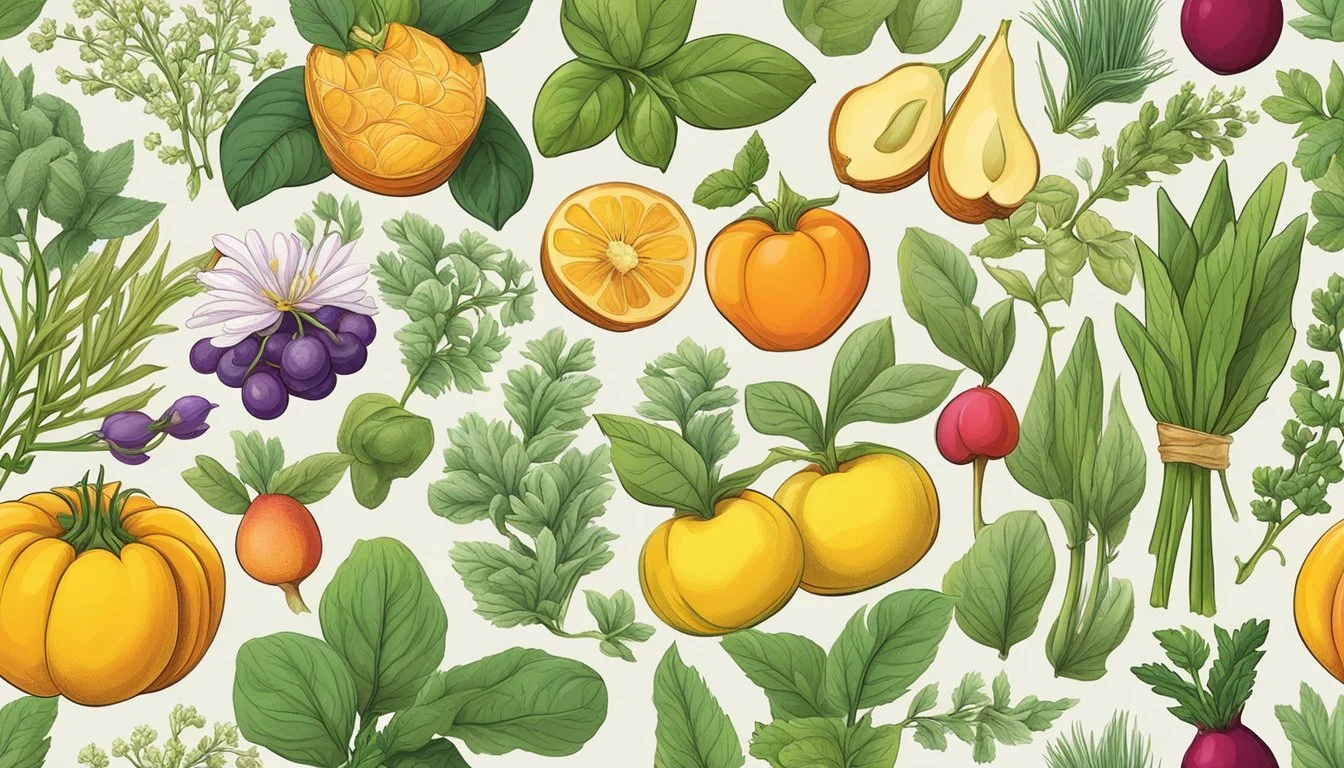Seasonal Fruit and Vegetables June
Your Guide to Fresh Picks
This Article is Part of Our Guide to Seasonal & Local Produce in the USA
June marks the transition into the heart of summer, bringing a bounty of fresh and vibrant fruits and vegetables that reach their peak during this month. The plentiful sunshine and warmer temperatures encourage the growth of a wide variety of produce. Consumers can look forward to adding flavor and color to their meals with an abundance of seasonal options.
Seasonal fruits that come into their prime in June include juicy berries like strawberries, blueberries (how long do blueberries last?), and raspberries, which are perfect for desserts or as a healthy snack. Stone fruits, such as cherries (how long do cherries last?), peaches, and nectarines, also begin to hit the market, offering sweet and succulent flavors. Meanwhile, tropical fruits like mangoes and pineapples provide a taste of the exotic and are readily available.
The vegetable selection is equally impressive, with leafy greens like lettuce and spinach thriving during early summer. Cucumbers and zucchinis (What wine goes well with zucchini?) are at their crispest, and colorful bell peppers and sweet corn add variety to any dish. Root vegetables like carrots maintain their presence from the spring and continue to be a reliable choice for consumers seeking farm-fresh produce. Whether for grilling, salads, or simply to enjoy raw, June’s produce offers freshness at every turn.
What’s in Season in June in Your State?
Texas Seasonal Fruit and Veg in June
Benefits of Seasonal Produce
Seasonal produce offers a variety of benefits ranging from enhanced nutritional value to positive environmental and economic impacts. This section breaks down how seasonal fruits and vegetables in June can offer superior benefits across these facets.
Nutritional Value and Flavor
Seasonal fruits and vegetables are typically harvested at their peak ripeness, which means they are not only bursting with flavor, but also rich in antioxidants and nutrients. For instance, a ripe, seasonal strawberry in June will often have a sweeter taste and a higher concentration of beneficial compounds compared to one that has been shipped halfway across the world out of season.
Seasonal Produce Notable Nutrients Strawberries Vitamin C, Manganese Peas Vitamin K, Fiber Cherries Antioxidants, Vitamin C
Environmental Impact
Choosing seasonal and locally sourced produce reduces the carbon footprint associated with long-distance transportation. It also minimizes the need for storage facilities and preservatives often required to keep out-of-season produce "fresh" during transport. Thus, a consumer prioritizing seasonal produce indirectly contributes to a healthier planet.
Economic Advantages
Economically, consumers can benefit from lower prices due to the abundance and decreased transport costs of seasonal produce. In June, markets and stores are likely to have competitive pricing on local cherries and peas, making it an advantageous time for both the wallet and health. Additionally, supporting local farmers keeps money within the community, bolstering the local economy.
To stay informed, shoppers can refer to a seasonal produce guide, which provides a month-by-month breakdown of the produce that is in season to ensure maximum availability and quality.
June’s Seasonal Fruits
June marks a vibrant time for fruit selection, offering a bounty of choices that are both sweet and refreshing. Consumers have the luxury of indulging in a variety of berries, stone fruits, and exotic options, each boasting their peak flavors.
Berry Varieties
Berries in June are notably sweet and full of flavor. Strawberries reach their peak, offering a mix of sweetness and slight acidity, perfect for jams or fresh consumption. Blueberries, rich in antioxidants, are another summer staple ideal for baking or as a healthy snack. Other popular berries include:
Raspberries: tender and sweet
Blackberries: juicy with a balance of tart and sweet
Stone Fruits
Stone fruits come into full swing in June. Cherries, both sour and sweet varieties, can be pitted and frozen for later use, or enjoyed fresh from the market. Peaches and nectarines provide juicy, fragrant options great for pies or eaten as is. Also available are:
Apricots: small, with a velvety skin and a sweet-tart flavor
Plums: diverse in color and taste, ranging from sweet to tart
Tropical and Exotic Selections
Exotic fruits signal the start of summer, with mangoes leading the charge as a tropical favorite that's juicy and full of vitamins. Other tropical fruits to look out for include:
Papaya: offering a sweet, musky essence and a buttery texture
Pineapple: with its distinct tang and sweetness
Melons and Citrus
Melons serve as a refreshing choice during warmer days, with watermelons showcasing their classic juicy, sweet taste. While not as prominently featured as in other months, select citrus fruits may still be available, with varieties like lemons continuing to offer their tart, tangy juice to brighten dishes.
June’s Seasonal Vegetables
As the summer heat intensifies in June, a variety of vegetables reach their peak, offering a bounty that is both flavorful and nutritious. These seasonal offerings can be divided into categories such as leafy greens and salad ingredients, root vegetables and tubers, podded vegetables and legumes, and summer squashes.
Leafy Greens and Salad Ingredients
June brings a wealth of leafy greens and salad ingredients. Lettuce varieties thrive, ranging from Romaine to Butterhead. Arugula, with its peppery flavor, is another excellent choice for salads. Kale and collard greens offer a heartier texture and are rich in nutrients.
Lettuce (e.g., Romaine, Butterhead)
Arugula
Kale
Collard greens
Root Vegetables and Tubers
Root vegetables and tubers that are in season include beets (how long do beets last?), radishes, and new potatoes. Their earthy flavors are perfect for roasting or boiling. Beets provide vibrant color and sweetness, while radishes add a crisp, peppery note to dishes. New potatoes have a tender skin and can be boiled, roasted, or grilled.
Beets
Radishes
New Potatoes
Podded Vegetables and Legumes
Podded vegetables like snow peas and green beans are at their best in June. They can be found fresh and are ideal for light cooking methods like steaming or stir-frying. Both green beans and snow peas are crisp and can be a vibrant addition to salads or side dishes.
Green beans
Snow peas
Summer Squashes
Zucchini and summer squash are prolific during the month of June. These vegetables are incredibly versatile, suitable for grilling, sautéing, and even spiralizing into noodles. Zucchini can also be used in baking to create moist cakes and bread.
Zucchini
Summer squash
Each category of June's seasonal vegetables offers a unique set of flavors and textures that can enhance a variety of dishes.
Selecting and Storing Tips
When selecting seasonal produce in June, one should look for freshness and ripeness, indicators of high-quality fruits and vegetables. Proper storage is key to ensuring they maintain their flavor and nutritional value.
Fruits
Berries (Strawberries, Blackberries, Blueberries): Look for plump, firm, and brightly colored berries. Store in the refrigerator and wash just before use.
Cherries: Choose cherries that are glossy and deep in color with green stems attached. Keep in the fridge in a plastic bag.
Peaches: Select fragrant peaches that are slightly soft to the touch. Ripen at room temperature, then store in the fridge.
Vegetables
Corn: Look for bright green husks with moist silk. Store in the refrigerator with the husks on for up to two days.
Green Beans: Choose firm, bright green beans without blemishes. Store in a plastic bag in the fridge.
Peas: Fresh peas should be plump and green. Keep them in an airtight container in the fridge.
June-Inspired Recipes
June brings a vibrant selection of fruits and vegetables perfect for fresh and flavorful dishes. This section provides an array of recipes that celebrate the produce of the season, offering something for every taste and meal of the day.
Salads and Cold Dishes
June's bounty offers an abundance of ingredients for refreshing salads and cold dishes. Favorites include:
Grilled Carrot Arugula Salad: Incorporating grilled carrots, (What wine goes well with grilled carrots?) arugula, figs, goat cheese, and avocado, this salad strikes a balance between the sweetness of summer fruit and the tang of goat cheese.
Chopped Thai-Inspired Chickpea Salad: The curry peanut dressing adds a bold flavor to this salad, making it a heartier option filled with textures and summer flavors.
Main Courses
Savory dishes featuring June produce can range from light to hearty, suitable for lunches and dinners alike:
Roasted Vegetable Platter: A versatile dish where one can mix and match vegetables like zucchini and green beans, roasting them to perfection with olive oil and garlic.
Brown Butter Goat Cheese Grilled Veggie Orzo: (how long does orzo last?) This dish combines the richness of brown butter and goat cheese with the fresh taste of grilled seasonal vegetables.
Desserts and Sweet Treats
Desserts crafted from June's fruits bring out their natural sweetness:
Berry Pies: Summer berries like strawberries and blueberries, at their peak in June, make for delicious pies with the perfect balance of sweetness and tartness.
Ice Cream: Homemade ice cream with fresh fruits like apricots or cherries is a creamy delight that's especially satisfying on hot June days.
Beverages and Smoothies
Cool off and hydrate with drinks that utilize June’s fresh produce:
Berry Smoothies: Combine blueberries, strawberries, and even cherries for a nutritious and revitalizing smoothie.
Cucumber Water: Infused with fresh cucumber slices, this simple beverage is not only hydrating but also incredibly refreshing.
Herbs and Aromatic Pairings
In June, gardens and markets abound with fresh herbs, each bringing its own distinctive flavor and aromatic qualities that can transform a simple dish into something exceptional. Chefs and home cooks alike prize these seasonal greens for their ability to infuse meals with depth and character.
Among the variety available, basil stands out for its sweet, yet peppery essence. It’s a perfect companion to tomato-based dishes and is the star of classic pesto. Basil also complements strawberries and peaches, enhancing the fruits' natural sweetness.
Sage, with its earthy and slightly peppery taste, is robust enough to stand up to heartier dishes. It pairs well with meats, especially pork, and shines in stuffings. For a quick aromatic touch, one could crisp sage leaves in butter and drape them over dishes for a fragrant accent.
Mint offers a cooling effect, making it ideal for summer refreshments and desserts. Its clean, refreshing quality can be a bright contrast to the richness of lamb or the sweetness of peas. Think beyond the mojito—mint can also spark life into grain salads or yogurts.
Oregano has a bold, woodsy flavor, a staple in Mediterranean cuisines. It's a critical herb for marinating grilled vegetables (What wine goes well with grilled vegetables?) or meats and is essential in Greek salads or sprinkled atop pizza for that quintessential Italian flair.
Here's a table of simple aromatic pairings for June harvests:
Herb Ideal Pairings Basil Tomatoes, Peaches, Strawberries, Pesto Sage Pork, Poultry, Squashes, Beans Mint Lamb, Peas, Grain Salads, Yogurt Oregano Grilled Vegetables, Pizza, Greek Salads
Through the thoughtful use of these herbs, dishes receive a burst of flavor that is both grounded in tradition and inviting to the senses. Careful pairing ensures that the inherent qualities of each ingredient are respected and accentuated, promising a delightful culinary experience.
Sustainability and Support Local
Purchasing seasonal fruits and vegetables in June directly benefits the environment and bolsters local economies. The sustainability of food systems is intertwined with local purchasing patterns, especially during the transition from spring to early summer.
Farmers Markets and Community-Supported Agriculture
Farmers markets come to life in June, showcasing the shift from spring to early summer harvests. Shoppers find local, fresh produce that travels minimal distances, reducing carbon emissions associated with long-distance transport. By purchasing strawberries or zucchini, customers directly support farmers and decrease demand for out-of-season imports.
Community-Supported Agriculture (CSA) programs flourish during this period. By subscribing to a CSA, consumers receive a regular supply of seasonal produce, sharing the risks and rewards of farming with local growers. This direct partnership reinforces the community's economy and fosters a sustainable, localized food system.





